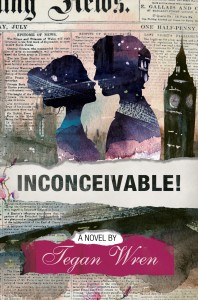 [Disclosure: This post forms part of a cross-promotion; it is also my pleasure. Tegan Wren interviewed me in July 2015 for her blog, www.teganwren.com.]
[Disclosure: This post forms part of a cross-promotion; it is also my pleasure. Tegan Wren interviewed me in July 2015 for her blog, www.teganwren.com.]
Whether you’re an avid reader, aspiring author—or both!—Tegan provides terrific tips and insights into her debut book, INCONCEIVABLE! It’s a delightful, engaging and well-paced tale, centering on a young royal couple grappling with infertility. Many of us feel pressure to provide grandchildren – imagine having to provide an heir to the monarchy! I also enjoyed how the subplot was woven through, adding texture and shifting gears from the personal to the wider community.
Here’s the Amazon link: http://amzn.to/1VWvLpG
Alicia: Tell us about your writing routine.
Tegan: I usually write in the evening after my three young children are asleep. I typically type my stories on a laptop in bed with a cat (or two!) curled up in my lap. This is my quiet time, so I don’t typically listen to music while I write in the evening. On the rare occasion when I get to write during the day, I strongly prefer to write at a coffeehouse where I can sip a hot cup of joe while I work.
Alicia: The premise of infertility offers a fresh twist on modern novels. How much of Inconceivable! is autobiographical, and did that make it easier or more challenging at times?
Tegan: Thank you for saying it’s a fresh twist! I agree—this topic is not often explored in depth in modern novels. I’m hard pressed to give an accurate estimate as to how much of the details are autobiographical. Unlike Prince John, who has a bit of a hard time with the whole infertility situation in the early stages as some men do, my husband was completely supportive from the very beginning. Like Hatty, I was in my 20’s when I first discovered I was having trouble conceiving and was otherwise healthy and fit. I wanted to focus on this age group because in movies and tabloid stories, stories often center on women who are in their late 30’s to 40’s and delayed their decision to try to conceive. Those are important stories to tell and my heart breaks for those women. However, based on my own experience, I felt a need to tell a story about infertility impacting a young woman.
The book implies Hatty may have endometriosis, though she never has the outpatient surgery to confirm it. I did, but even with the diagnosis and treatment of endo, I still couldn’t conceive. I’m a person of Christian faith, as is Hatty, and infertility did prompt me to ask some serious questions within the context of my faith. Hatty, who is living in Europe and does not have a faith support system there, struggles a bit more than I did with reconciling her faith and infertility. I definitely struggled, but she has a harder time. I felt that was a really important aspect to show because serious medical challenges do intersect with our beliefs in ways that may make some people uncomfortable, especially those who haven’t walked this lonely path. People who haven’t experienced infertility may hand out pithy spiritual advice that ultimately is not helpful in addressing the person’s underlying feelings of shame over a body that isn’t doing what it was made to do, guilt, jealousy, anger, profound sadness, grief, and so on. And really, this is one of the main reasons I wrote this book: to cultivate more compassion for people slogging their way through infertility.
Alicia: Tips and insights on laying out a plot?
Tegan: As a reader, the plot is very important to me. I don’t have a lot of patience for too much description or character studies. I think that’s reflected in my writing because I like to establish and maintain a pace that moves along. The best plots surprise us (without requiring us to stretch our suspension of disbelief too much), speak truth to us, and provide a satisfying ending (it may or may not be happy). So, those are my goals in laying out a plot. I create a plot outline that shows the skeleton of where my story will go. Then, as I write the “meat” that goes on the skeleton, that’s where you start to see the colors of the story emerge and blend together. I let my characters drive me from plot point A to plot point B. Sometimes, they choose a straight, direct path. Other times, it winds and takes unexpected turns. The more intricate the connections between the parts of the skeleton, the more firmly it’s all held together and the better it flows. Subplots are a part of the “meat” and move along in parallel to the main action, but still connect to the plot skeleton. That’s how I avoid letting my subplots wander too far afield of the main action.
Alicia: You have a background in journalism, as done your main character. What considerations factor in when you assign personality traits/ quirks, backstory or a name to a character?
Tegan: For me, the name of the character is very important. The name carries specific connotations for me, and those connotations help shape the personality and traits. I’ve completed two novels and have a third in progress. For all of them, I have a character “cheat sheet” that gives characters’ name, birth date, physical quirks (sometimes this is a useful tool to help readers differentiate between characters), special connections/relationships to other characters, very important dates in their lives, and any other notes about the characters that I may need to remember as I write. I’ve found I reference my character cheat sheet countless times. Developing the entry for each character forces me to think about his/her back story and life outside the pages of my book. This adds depth to a novel.
Alicia: Any other works in the pipeline?
Tegan: I just finished a contemporary young adult novel about a teenage girl who flees the scene of a fatal car crash. It’s a coming of age story with a tone and voice that’s quite different from INCONCEIVABLE! It’s going to beta readers very soon. I hope to begin querying agents with it this fall. For INCONCEIVABLE! I secured a publishing deal with Curiosity Quills Press without an agent. This is an independent publisher that works with both agented and un-agented writers. I’m really pleased to be working with them on my debut novel, but I hope to find an agent to represent my second novel.
Finally, I’ve started an adult contemporary romance called CHANDELIERS. It’s about a French language teacher from the U.S. who’s taking part in a reenactment at Versailles and experiences a time slip. She finds herself at the court of Louis XVI and Marie Antoinette, and she soon discovers she’s not the only person from the present day who’s gone back in time. A handsome doctor is there, too. I’ve long had a love of Versailles and Marie Antoinette, so I’m writing a book I’ve always wanted to read. [SL]
My thanks to Tegan for her time and insight. You can check out the book’s Amazon link here: http://amzn.to/1VWvLpG



Recent Comments